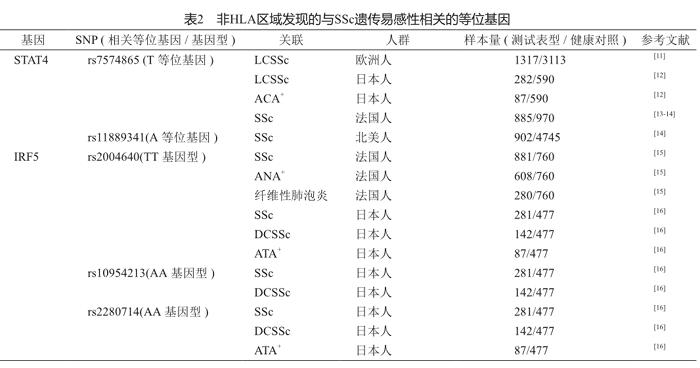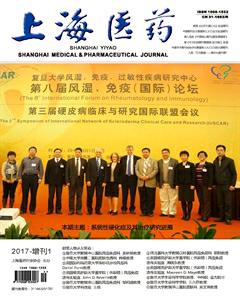系统性硬化症遗传学研究进展
濮伟霖+郭士成+王久存
摘 要 系统性硬化症又称为硬皮病,是一种复杂的自身免疫性疾病,目前对于该疾病的病因了解尚不清晰。多项研究显示,遗传因素在硬皮病的发病过程中起重要作用。因此对于硬皮病遗传因素的探索有助于我们发现硬皮病发病的相关通路和分子机制。本文介绍并综述了硬皮病截止目前的遗传学相关研究的前沿进展。
关键词 硬皮病 遗传 全基因组关联研究(GWAS)
中图分类号:R593.25 文献标识码:A 文章编号:1006-1533(2017)S1-0030-07
The review of the advancement of SSc genetic studies*
PU Weilin**, GUO Shicheng, WANG Jiucun***
(Department of Life Sciences, Fudan University, Shanghai 200438, China)
ABSTRACT Systemic sclerosis is a kind of complex autoimmune diseases with different manifestations. The pathogenesis of SSc is still unknown. Multiple studies have revealed the important role of genetic factors in the pathogenesis of SSc. As a result, the exploration of the genetic factors of SSc will be of great benefit to the discovery of the associated pathways and mechanisms of SSc pathogenesis. This paper summarizes the advances and leading edge of the SSc genetic studies till now.
KEY WORDS Scleroderma; Genetics; genome-wide association study (GWAS)
系統性硬化症(systemic sclerosis,SSc,又称硬皮病)是不明病因的复杂性自身免疫性疾病。多项研究已经发现系统性硬化症的发病与遗传因素密切相关。从早期的候选基因研究到近年来的全基因组关联研究,大量的遗传易感因素与硬皮病的临床表型密切相关,提示遗传因素对于硬皮病的发病具有重要作用。近年来,随着基因芯片及高通量测序技术的进步和价格的不断下降,使得对于复杂疾病的遗传因素解析更为便捷。本文综述了从早期至近期的硬皮病遗传学研究进展。
1 系统性硬化症的早期遗传学研究
在SSc研究早期,美国德克萨斯大学学者Arnett对俄克拉荷马州21 255名Choctaw 印第安人进行研究,发现Choctaw 印第安人系统性硬皮病(即系统性硬化症,SSc)发病率远高于正常人群,且未发现显著环境因素差异,故提示可能存在遗传因素影响[1]。早期研究已经发现SSc患者体内可产生自身抗体。而HLA II 型分子可以将处理后的抗原呈递给T细胞,从而产生抗原特异性的反应,说明HLA区域和系统性硬皮病的发生密切相关。此外,当时在其他美国印第安人中也发现了HLA区域与其他自身免疫性疾病如风湿病和结缔组织病相关。故Arnett等用12个患者样本和48个对照样本研究HLA区域与SSc的关联,发现3个HLA区域的等位基因与SSc相关,分别为DRB1*1602、DQB1*0301和DQA1*0501。
这一研究成果确认了SSc与HLA区域的相关性,随后针对HLA区域和系统性硬皮病(SSc)遗传易感性之间的关联研究逐渐增多,并陆续发现HLA区域的多个等位基因与SSc遗传易感性相关(表1)[2]。
SSc作为一种复杂的自身免疫性疾病,除了自身免疫被激活外,其特征还包括微血管的损伤和皮肤及内脏的纤维化,因此SSc的发生除了与HLA区域的基因密切相关外,也与非HLA区域的基因密切相关。故在HLA基因与SSc的关系不断被揭示时,也有许多研究发现SSc与非HLA区域的基因之间的关联(表2)[9-10]。
1.1 IRF5
IRF5 (interferon regulatory factor 5,干扰素调节因子5) 是 I型干扰素(type I IFN) 信号通路中的重要调节因子。而干扰素(interferon, IFN)是固有免疫的重要组成部分,可以通过激活NK细胞、细胞毒性T细胞,促进单核细胞和浆细胞的成熟等方式来应对感染。一项法国的研究利用法国高加索人群(881 病例/760对照)发现IRF5 内含子区域rs2004640 T 等位基因与SSc相关联[15]。随后另一项日本的研究(281病例/477对照)确认IRF5了 rs2004640与SSc的关联,并发现rs10954213和rs2280714这两个SNP也与SSc关联[16]。
1.2 STAT4
STAT4(signal transduction and activator of transcription-4,信号转导和转录激活因子4)属于转录因子家族,参与Th1和Th17细胞的分化过程。已有研究证明STAT4基因与SLE和RA均相关[32]。目前已发现STAT4基因的多个SNP和SSc相关。在一项包括了5个欧洲高加索人群的共计1 317名SSc病例和3 113名正常对照的研究中,发现STAT4 上的rs7574865 T 等位基因和lcSSc相关,但与dcSSc不相关[19]。随后的两个GWAS研究均证明了STAT4基因和SSc之间的关联[28,31]。


1.3 CTGF
CTGF(connective tissue growth factor,结缔组织生长因子)可以通过胶原和细胞外基质的生成来参与纤维化的过程。已发现在SSc病人血清中CTGF表达量上调[33]。一项英国的病例对照研究(500病例/500对照)首次发现CTGF上945G等位基因和SSc相关[34]。随后,日本的一项SSc研究(395病例/269对照)验证了CTGF和SSc的关联[35]。但是,一项多中心的法国SSc研究(1 180病例/1 784对照)没能验证CTGF和SSc之间的关联[11]。这些研究说明CTGF和SSc的关联尚待进一步的研究确认。
1.4 BANK1
BANK1(B cell scaffold protein with ankyrin repeats,具有锚蛋白重复序列的B 细胞支架蛋白)基因编码BANK1蛋白,BANK1蛋白是一种B细胞适配蛋白,可以与B细胞上受体和B细胞下游激酶结合。已有研究确认BANK1与RA和SLE相关,提示BANK1也可能与SSc相关[11,17,36]。在一项包括2 380名SSc患者和3 270名正常对照的多中心研究中,发现rs10516487G 和rs17266594T 等位基因和dcSSc关联[17]。随后的德国和法国的研究也确认了上述等位基因和dcSSc之间的关联[18]。
2 SSc全基因组关联研究进展
从2009年至今,已发表4篇SSc的全基因组关联研究(GWAS),通过大样本量研究,确认了早期发现的多个基因与SSc的关联,同时也发现了多个新的与SSc相关的基因。
第一项针对SSc的GWAS研究利用137名韩国SSc患者和564名正常对照,发现HLA-DPB1和HLA-DPB2上5个SNP rs3128930A、 rs7764491C、rs7763822T、rs3128965A和rs3117230G與SSc亚型ATA(antitopoisomerase I,抗拓扑异构酶I)阳性相关。在验证阶段该研究采纳了110名美国高加索裔SSc病人和2 747名正常对照,成功验证两对SNP rs7763822/rs7764491和rs3117230/rs3128965与ATA+或ACA+相关[37]。
2010年,Mayes等发表了迄今最大规模的SSc GWAS研究。这项研究包括了美国、西班牙、德国和荷兰的共计2 296名SSc患者和5 171名正常对照,发现多个SNP在经过多重检验矫正后P值仍然达到了GWAS的显著水平(P≤5×10-7)。其中,HLA-DQB1基因的SNP rs6457617 最为显著。在MHC区域外,包括TNPO3/IRF5、STAT4、CD247、CDH7、EXOC2/IRF4在内的5个基因达到了GWAS显著水平。随后,在验证阶段,该研究纳入了2 753名高加索SSc患者和4 569名正常对照,结果CDH7和EXOC2/IRF4未能通过验证。其他通过验证的三个基因中,STAT4和IRF5与SSc的关联之前已经发现,而CD247是首次发现与SSc相关[28]。
2011年,Martin 等利用2010年SSc GWAS的数据,扩大了验证阶段的样本量,合并样本量达到5 471例SSc病人和10 143例正常对照。该研究合并分析后发现IRF8基因上的SNP rs11642873与lcSSc相关,且P值(2.32×10-12)达到了GWAS的显著水平。而另外两个基因GRB10和SOX5分别和lcSSc(P=1.27×10-6)和ATA(1.39×10-7)阳性相关,但是P值略低于GWAS的显著水平,提示这两个基因可能也与SSc相关,但尚需进一步确认[30]。
同在2011年,法国的Allanore等[31]也发表了一项GWAS研究,他们主要利用法国SSc样本,并在验证阶段中包括了意大利、德国等多个种族的人群,合并样本量达到1 682例病人和3 926例正常对照。该研究发现HLA区域的PSORS1C1(P=5.7×10-10)和HLA-DQB1(P=2.33×10-37)与SSc相关。而在HLA区域之外,还发现了RHOB和TNIP上的多个SNP可能与SSc相关。
2013年,Martin等对SSc和SLE进行了一项metaGWAS研究。他们利用Mayes[28]的SSc GWAS研究数据和Harley[38] 的SLE GWAS数据,将这两篇GWAS研究合并,从中筛选20个共有的SNP进行验证。该研究在验证阶段纳入了1 578例SSc病例和3 446名正常对照以及1 727例SLE病例和3 447例正常对照,总计样本量达到21 109例。该研究结果发现KIAA0319L基因(P=3.31×10-11)是SSc和SLE共同的新发现的关联基因,并首次发现SLE的易感基因PXK(P=3.27×10-11)和JAZF(P=1.11×10-8)与SSc相关联[39]。
除了传统的GWAS之外,Mayes等于2014年首次完成了SSc的Immunochip的研究。他们利用Immunochip对1 833名SSc病例和3 466名正常对照进行检测,在HLA区域发现了6个氨基酸多态位置和7个SNP与SSc相关。而在非HLA区域,该研究利用4 017名SSc病例和5 935名正常对照进行了验证,合并样本量达到5 835/9 401,发现了DNASE1L3、CHIPIL12A和ATG53个基因与SSc和SSc的亚型相关。其中DNASE1L3与SSc(P = 3.36×10-16),ATA+(4.25×10-31)和lcSSc(P = 1.28×10-20)均相关,SCHIP-IL12A也与SSc(P= 1.22×10-11),ATA+(2.40×10-8)和lcSSc(P = 1.53×10-11)均相关,而ATG5则与SSc相关(P = 3.75×10-8)[40]。
3 SSc多态位点在中國汉族人群中的验证
不同种族人群存在着遗传结构差异,硬皮病的流行病学特征在不同地区及种族中具异质性,因此有必要对不同种族人群进行比较研究,以发现影响硬皮病的关键基因或位点。在高加索人中发现及验证过的多态位点是否也是汉族人群SSc的易感位点需要在汉族人群样本中进行研究。
本实验室及合作者于2013年利用453例汉族SSc患者和534例正常对照进行研究,发现中国汉族人群中 STAT4基因上的两个SNP(rs7574865和rs10168266)与SSc相关。其中rs7574865的基因型GG(P = 4.1×10-3)和等位基因T(P = 4.1×10-4)在SSc病人中出现频率与正常对照中频率存在明显差异,而rs10168266 的基因型GG(P = 0.005 1)和等位基因T(P = 0.005 1)在SSc病人中出现的频率与正常对照中频率也存在明显差异[41]。本项目组利用424例汉族SSc患者和502例正常对照研究后发现IRF5 rs2004640 TT 基因型在纤维化的SSc患者和ATA阳性患者中频率显著上升。且ACA+和lcSSc这两种亚型中IRF5 rs2004640 T 基因频率显著上升,成功验证了IRF5基因与汉族人群SSc的关联[42]。
本项目组利用213名汉族SSc患者和239名汉族正常对照在汉族人群中验证了HLA-DQB1*0501(P = 1.6×10-5)是汉族人群SSc的易感位点。而DQB1*0601与 ATA+ SSc(P = 0.031)相关联,DQB1*0303与antiU1RNP阳性(P = 0.02)关联[43]。此外,在汉族人群(585 SSc患者/458正常对照)中验证了HLA-DRB1的多个等位基因与SSc相关[44]。我们也在汉族人群中(338名SSc患者/480名正常对照)中验证出HLA-DPB1上的多个等位基因与SSc和SSc的亚型相关[45]。虽然2010年的最大规模GWAS研究中发现CD247与SSc相关,但我们在汉族人群中(387病例/523对照)未能验证出CD247基因与汉族人群SSc之间相关,说明CD247与SSc在汉族人群中的相关性尚需进一步确认[46]。
4 拷贝数变异
GWAS研究的原理基于常见疾病/常见变异的理论。虽然目前GWAS已经发现了一系列硬皮病易感基因及位点,但从根本上其只能发现频率高于5%的疾病相关遗传变异。因此目前GWAS发现的SSc易感位点只能解释很小一部分的性状遗传或致病风险。频率较低的单核苷酸多态性则无法通过现有GWAS方法进行研究,即目前的SSc的易感性研究中存在大量的遗传力丢失[47]。研究发现,拷贝数变异(CNV)在复杂疾病的易感性上也占有重要的贡献。最新的千人基因组发现CNV变异所涉及的基因组区域是SNP的10倍之多,因此,CNV可能对人类表型或疾病产生更加广泛的影响。目前基于全基因组CNV关联研究主要集中在肿瘤及心血管、神经系统疾病中,截至2015年,尚没有基于CNV的全基因组关联研究在SSc中开展,但已经有一些基于候选基因方法的CNV关联研究。2010年Zorzetto博士基于意大利人群的研究结果显示C4基因(6p21.3)的拷贝数变异与SSc的易感性显著相关。2012年McKinney博士通过对777位欧洲高加索SSc患者和1 000正常人的研究发现FCGR3B拷贝数缺失是SSc的一个风险遗传变异[48]。本实验室2014年首次利用比较基因组杂交方法(CGH)开展了针对中国人群的全基因组CNV关联研究,发现在中国汉族SSc人群中存在大量的候选易感性CNV位点,并通过大样本人群实验表明HLA-DQA1和APOBEC3A/3B基因的CNV对SSc的易感性具有显著的贡献[49]。
5 全外显子组研究
随着高通量测序技术价格的不断下降,个人基因组测序的成本急剧下降,使得基于全基因组或全外显子组测序的大样本疾病遗传学研究成为可能。Gao等于2016年首次利用全外显子测序技术对78例欧洲高加索硬皮病患者进行测序。该研究利用公共数据库中的3 179例正常样本的全外显子数据作为对照,发现ATP8B4基因频率在硬皮病患者和正常对照中存在显著差异(P= 2.77×10-7)。深入研究发现ATP8B4基因中的rs55687265位点的差异最为显著(P=9.35×10-10)。随后于第二阶段利用415例硬皮病患者和2 848例正常对照,对第一阶段的结果进行验证。合并分析的结果也验证了该位点与硬皮病的发病相关(P=1.92×10-7, OR=2.5)。此外,该研究还发现ASB10、CNGB3和HLA-DRB5和HSPB2等基因可能与硬皮病的发病存在可能的相关性,需要更多的研究加以确认[50]。
6 结语
截止目前,包括本实验室在内,通过高通量的芯片技术和测序技术发现了大量与硬皮病发病相关的风险和保护位点,使我们对于硬皮病发病的遗传机制有了深入的了解。但由于硬皮病患病率低,研究的样本量较小,同时研究技术手段的局限也使得对于硬皮病遗传背景的了解尚待深入。随着高通量测序技术的开展,相信在近期可对硬皮病的遗传风险因素有更加细致的了解,同时对其作用和功能进行更为精细的描述和认识。
参考文献
[1] Arnett FC, Howard RF, Tan F, et al. Increased prevalence of systemic sclerosis in a Native American tribe in Oklahoma. Association with an Amerindian HLA haplotype[J]. Arthritis Rheum, 1996, 39(8): 1362-1370.
[2] Martin JE, Bossini-Castillo L, Martin J. Unraveling the genetic component of systemic sclerosis[J]. Hum Genet, 2012, 131(7): 1023-1037.
[3] Muller-Hilke B. HLA class II and autoimmunity: epitope selection vs differential expression[J]. Acta Histochem, 2009, 111(4): 379-381.
[4] Simeon CP, Fonollosa V, Tolosa C, et al. Association of HLA class II genes with systemic sclerosis in Spanish patients[J]. J Rheumatol, 2009, 36(12): 2733-2736.
[5] Gilchrist FC, Bunn C, Foley PJ, et al. Class II HLA associations with autoantibodies in scleroderma: a highly significant role for HLA-DP[J]. Genes Immun, 2001, 2(2): 76-81.
[6] Arnett FC, Gourh P, Shete S, et al. Major histocompatibility complex (MHC) class II alleles, haplotypes and epitopes which confer susceptibility or protection in systemic sclerosis: analyses in 1300 Caucasian, African-American and Hispanic cases and 1000 controls[J]. Ann Rheum Dis, 2010, 69(5): 822-827.
[7] Rands AL, Whyte J, Cox B, et al. MHC class II associations with autoantibody and T cell immune responses to the scleroderma autoantigen topoisomerase I[J]. J Autoimmun, 2000, 15(4): 451-458.
[8] Kuwana M, Inoko H, Kameda H, et al. Association of human leukocyte antigen class II genes with autoantibody profiles, but not with disease susceptibility in Japanese patients with systemic sclerosis[J]. Intern Med, 1999, 38(4): 336-344.
[9] Broen JC, Coenen MJ, Radstake TR. Deciphering the genetic background of systemic sclerosis[J]. Expert Rev Clin Immunol, 2011, 7(4): 449-462.
[10] Broen JC, Coenen MJ, Radstake TR. Genetics of systemic sclerosis: an update[J]. Curr Rheumatol Rep, 2012, 14(1): 11-21.
[11] Rueda B, Simeon C, Hesselstrand R, et al. A large multicentre analysis of CTGF -945 promoter polymorphism does not confirm association with systemic sclerosis susceptibility or phenotype[J]. Ann Rheum Dis, 2009, 68(10): 1618-1620.
[12] Tsuchiya N, Kawasaki A, Hasegawa M, et al. Association of STAT4 polymorphism with systemic sclerosis in a Japanese population[J]. Ann Rheum Dis, 2009, 68(8): 1375-1376.
[13] Dieude P, Guedj M, Wipff J, et al. STAT4 is a genetic risk factor for systemic sclerosis having additive effects with IRF5 on disease susceptibility and related pulmonary fibrosis[J]. Arthritis Rheum, 2009, 60(8): 2472-2479.
[14] Gourh P, Agarwal SK, Divecha D, et al. Polymorphisms in TBX21 and STAT4 increase the risk of systemic sclerosis: evidence of possible gene-gene interaction and alterations in Th1/Th2 cytokines[J]. Arthritis Rheum, 2009, 60(12): 3794-3806.
[15] Dieude P, Guedj M, Wipff J, et al. Association between the IRF5 rs2004640 functional polymorphism and systemic sclerosis: a new perspective for pulmonary fibrosis[J]. Arthritis Rheum, 2009, 60(1): 225-233.
[16] Ito I, Kawaguchi Y, Kawasaki A, et al. Association of a functional polymorphism in the IRF5 region with systemic sclerosis in a Japanese population[J]. Arthritis Rheum, 2009, 60(6): 1845-1850.
[17] Rueda B, Gourh P, Broen J, et al. BANK1 functional variants are associated with susceptibility to diffuse systemic sclerosis in Caucasians[J]. Ann Rheum Dis, 2010, 69(4): 700-705.
[18] Dieude P, Wipff J, Guedj M, et al. BANK1 is a genetic risk factor for diffuse cutaneous systemic sclerosis and has additive effects with IRF5 and STAT4[J]. Arthritis Rheum, 2009, 60(11): 3447-3454.
[19] Ito I, Kawaguchi Y, Kawasaki A, et al. Association of the FAM167A-BLK region with systemic sclerosis[J]. Arthritis Rheum, 2010, 62(3): 890-895.
[20] Gourh P, Arnett FC, Tan FK, et al. Association of TNFSF4 (OX40L) polymorphisms with susceptibility to systemic sclerosis[J]. Ann Rheum Dis, 2010, 69(3): 550-555.
[21] Bossini-Castillo L, Broen JC, Simeon CP, et al. A replication study confirms the association of TNFSF4 (OX40L) polymorphisms with systemic sclerosis in a large European cohort[J]. Ann Rheum Dis, 2011, 70(4): 638-641.
[22] Dieude P, Guedj M, Wipff J, et al. Association of the TNFAIP3 rs5029939 variant with systemic sclerosis in the European Caucasian population[J]. Ann Rheum Dis, 2010, 69(11): 1958-1964.
[23] Wipff J, Dieude P, Guedj M, et al. Association of a KCNA5 gene polymorphism with systemic sclerosis-associated pulmonary arterial hypertension in the European Caucasian population[J]. Arthritis Rheum, 2010, 62(10): 3093-3100.
[24] Diaz-Gallo LM, Gourh P, Broen J, et al. Analysis of the influence of PTPN22 gene polymorphisms in systemic sclerosis[J]. Ann Rheum Dis, 2011, 70(3): 454-462.
[25] Dieude P, Guedj M, Wipff J, et al. NLRP1 influences the systemic sclerosis phenotype: a new clue for the contribution of innate immunity in systemic sclerosis-related fibrosing alveolitis pathogenesis[J]. Ann Rheum Dis, 2011, 70(4): 668-674.
[26] Lakos G, Melichian D, Wu M, et al. Increased bleomycin-induced skin fibrosis in mice lacking the Th1-specific transcription factor T-bet[J]. Pathobiology, 2006, 73(5): 224-237.
[27] Dieude P, Guedj M, Truchetet ME, et al. Association of the CD226 Ser(307) variant with systemic sclerosis: evidence of a contribution of costimulation pathways in systemic sclerosis pathogenesis[J]. Arthritis Rheum, 2011, 63(4): 1097-1105.
[28] Radstake TR, Gorlova O, Rueda B, et al. Genome-wide association study of systemic sclerosis identifies CD247 as a new susceptibility locus[J]. Nat Genet, 2010, 42(5): 426-429.
[29] Dieude P, Boileau C, Guedj M, et al. Independent replication establishes the CD247 gene as a genetic systemic sclerosis susceptibility factor[J]. Ann Rheum Dis, 2011, 70(9): 1695-1696.
[30] Gorlova O, Martin JE, Rueda B, et al. Identification of novel genetic markers associated with clinical phenotypes of systemic sclerosis through a genomewide association strategy[J]. PLoS Genet, 2011, 7(7): e1002178.
[31] Allanore Y, Saad M, Dieude P, et al. Genome-wide scan identifies TNIP1, PSORS1C1, and RHOB as novel risk loci for systemic sclerosis[J]. PLoS Genet, 2011, 7(7): e1002091.
[32] Remmers EF, Plenge RM, Lee AT, et al. STAT4 and the risk of rheumatoid arthritis and systemic lupus erythematosus[J]. N Engl J Med, 2007, 357(10): 977-986.
[33] Igarashi A, Nashiro K, Kikuchi K, et al. Significant correlation between connective tissue growth factor gene expression and skin sclerosis in tissue sections from patients with systemic sclerosis[J]. J Invest Dermatol, 1995, 105(2): 280-284.
[34] Fonseca C, Lindahl GE, Ponticos M, et al. A polymorphism in the CTGF promoter region associated with systemic sclerosis[J]. N Engl J Med, 2007, 357(12): 1210-1220.
[35] Kawaguchi Y, Ota Y, Kawamoto M, et al. Association study of a polymorphism of the CTGF gene and susceptibility to systemic sclerosis in the Japanese population[J]. Ann Rheum Dis, 2009, 68(12): 1921-1924.
[36] Kozyrev SV, Abelson AK, Wojcik J, et al. Functional variants in the B-cell gene BANK1 are associated with systemic lupus erythematosus[J]. Nat Genet, 2008, 40(2): 211-216.
[37] Zhou X, Lee JE, Arnett FC, et al. HLA-DPB1 and DPB2 are genetic loci for systemic sclerosis: a genome-wide association study in Koreans with replication in North Americans[J]. Arthritis Rheum, 2009, 60(12): 3807-3814.
[38] International Consortium for Systemic Lupus Erythematosus G, Harley JB, Alarcon-Riquelme ME, et al. Genome-wide association scan in women with systemic lupus erythematosus identifies susceptibility variants in ITGAM, PXK, KIAA1542 and other loci[J]. Nat Genet, 2008, 40(2): 204-210.
[39] Martin JE, Assassi S, Diaz-Gallo LM, et al. A systemic sclerosis and systemic lupus erythematosus pan-meta-GWAS reveals new shared susceptibility loci[J]. Hum Mol Genet, 2013, 22(19): 4021-4029.
[40] Mayes MD, Bossini-Castillo L, Gorlova O, et al. Immunochip analysis identifies multiple susceptibility loci for systemic sclerosis[J]. Am J Hum Genet, 2014, 94(1): 47-61.
[41] Yi L, Wang JC, Guo XJ, et al. STAT4 is a genetic risk factor for systemic sclerosis in a Chinese population[J]. Int J Immunopathol Pharmacol, 2013, 26(2): 473-478.
[42] Wang J, Yi L, Guo X, et al. Association of the IRF5 SNP rs2004640 with systemic sclerosis in Han Chinese[J]. Int J Immunopathol Pharmacol, 2014, 27(4): 635-638.
[43] Zhou XD, Yi L, Guo XJ, et al. Association of HLA-DQB1*0501 with scleroderma and its clinical features in Chinese population[J]. Int J Immunopathol Pharmacol, 2013, 26(3): 747-751.
[44] He D, Wang J, Yi L, et al. Association of the HLA-DRB1 with scleroderma in Chinese population[J]. PLoS One, 2014, 9(9): e106939.
[45] Wang J, Guo X, Yi L, et al. Association of HLA-DPB1 with scleroderma and its clinical features in Chinese population[J]. PLoS One, 2014, 9(1): e87363.
[46] Wang J, Yi L, Guo X, et al. Lack of Association of the CD247 SNP rs2056626 with Systemic Sclerosis in Han Chinese[J]. Open Rheumatol J, 2014, 8: 43-45.
[47] Hemminki K, Forsti A, Houlston R, et al. Searching for the missing heritability of complex diseases[J]. Hum Mutat, 2011, 32(2): 259-262.
[48] McKinney C, Broen JC, Vonk MC, et al. Evidence that deletion at FCGR3B is a risk factor for systemic sclerosis[J]. Genes Immun, 2012, 13(6): 458-460.
[49] Guo S, Li Y, Wang Y, et al. Copy Number Variation of HLA-DQA1 and APOBEC3A/3B Contribute to the Susceptibility of Systemic Sclerosis in the Chinese Han Population[J]. J Rheumatol, 2016, 43(5): 880-886.
[50] Gao L, Emond MJ, Louie T, et al. Identification of Rare Variants in ATP8B4 as a Risk Factor for Systemic Sclerosis by Whole-Exome Sequencing[J]. Arthritis Rheumatol, 2016, 68(1): 191-200.

